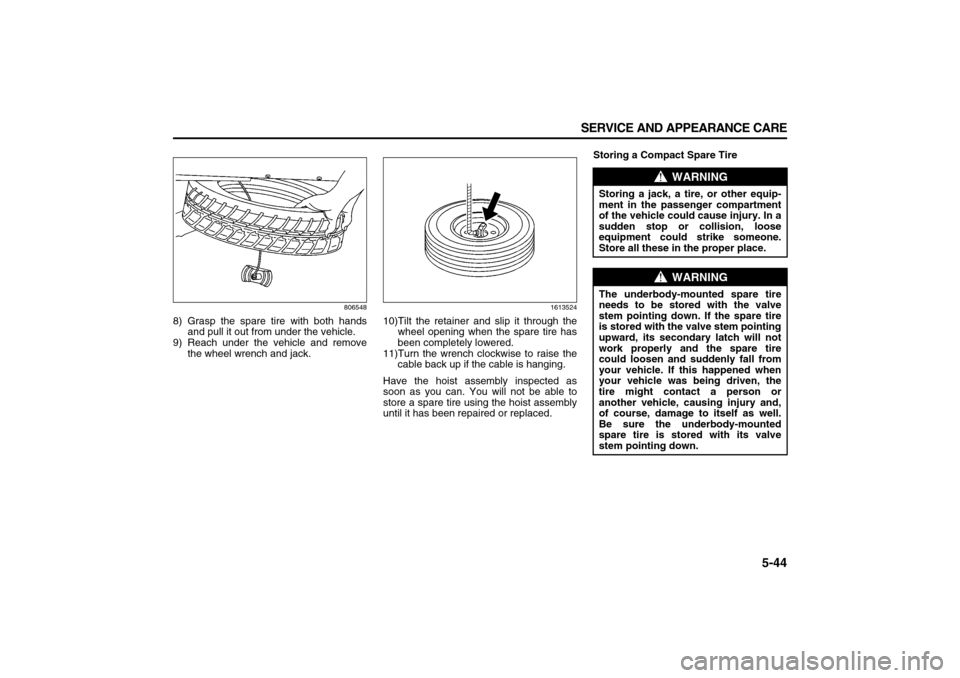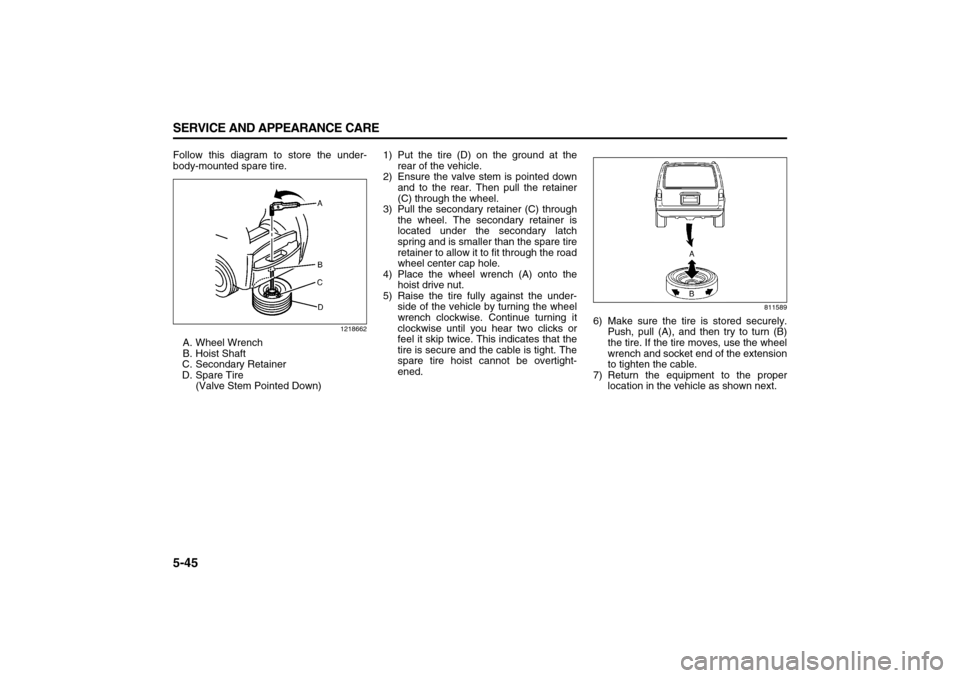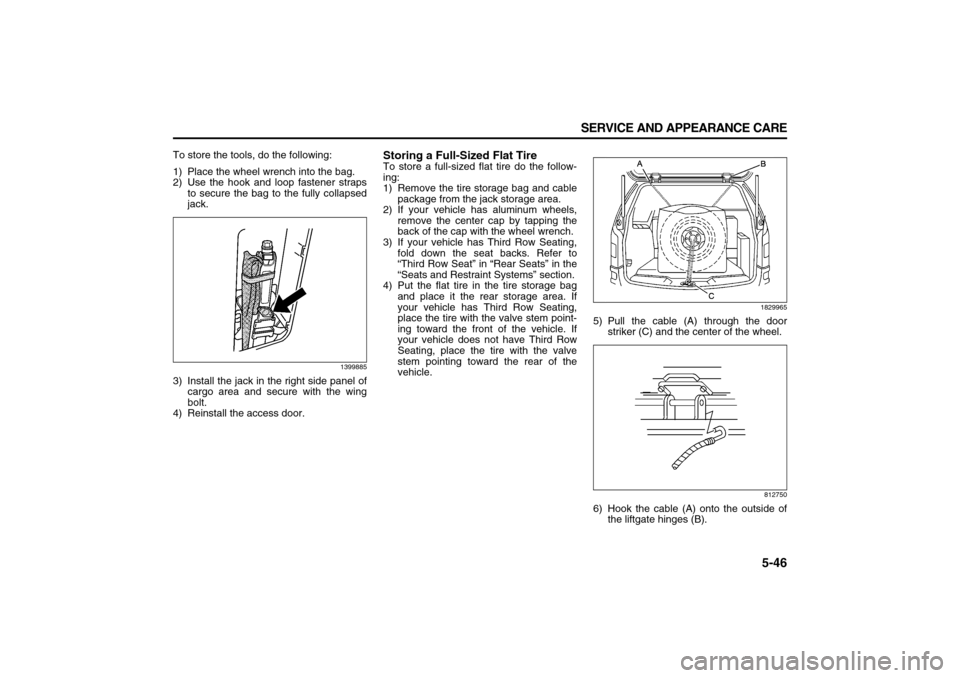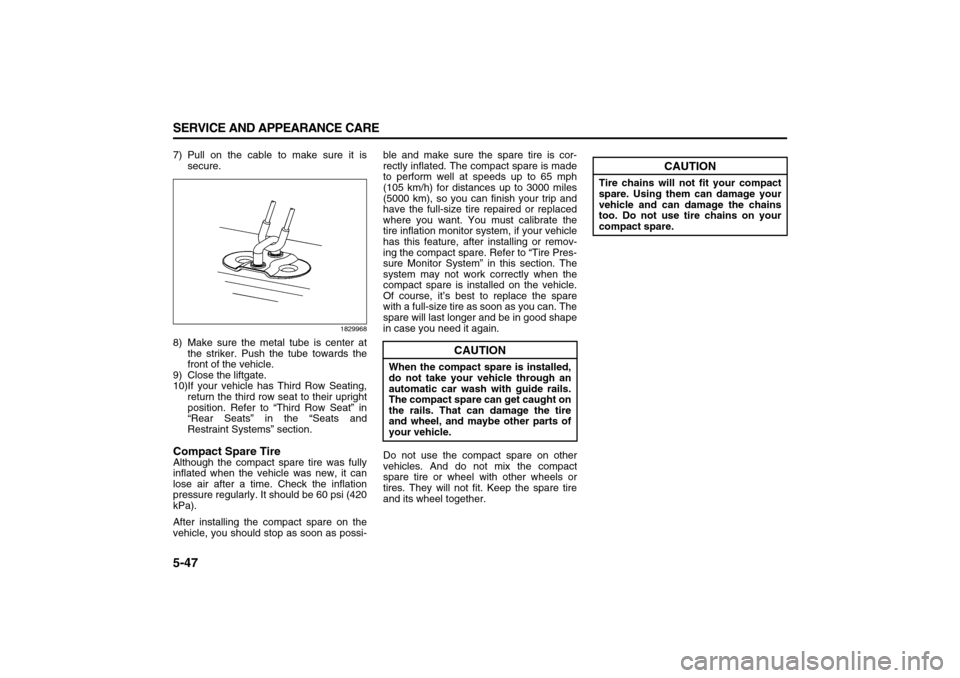2007 SUZUKI XL7 wheel
[x] Cancel search: wheelPage 227 of 274

5-43 SERVICE AND APPEARANCE CARE
78J00-03E
Secondary Latch System
Your vehicle has an underbody mounted
tire hoist assembly equipped with a sec-
ondary latch system. It is designed to stop
the compact spare tire from suddenly fall-
ing off your vehicle if the cable holding the
spare tire is damaged. For the secondary
latch to work, the tire must be stowed with
the valve stem pointing down. Refer to
“Storing a Flat or Spare Tire and Tools” in
this section for instructions on storing the
spare tire correctly.To release the spare tire from the second-
ary latch, do the following:
1) If the cable is not visible, start this pro-
cedure at Step 3.
806961
2) If the cable is visible, place the wrench
on the hoist drive nut and turn the
wrench counterclockwise until approxi-
mately 6 inches (15 cm) of cable is
exposed.
3) Attach the wheel wrench to the jack and
raise the jack at least 10 turns.
4) Place the jack under the vehicle, ahead
of the rear bumper. Position the center
lift point of the jack under the center of
the spare tire.
806546
5) Turn the wheel wrench clockwise to
raise the jack until it lifts the secondary
latch spring.
6) Keep raising the jack until the spare tire
stops moving upward and is held firmly
in place, this lets you know that the sec-
ondary latch has released.
7) Lower the jack by turning the wheel
wrench counterclockwise. Keep lower-
ing the jack until the spare tire is resting
on the wheel wrench.
WARNING
Before beginning this procedure read
all the instructions. Failure to read
and follow the instructions could
damage the hoist assembly and you
and others could get hurt. Read and
follow the instructions listed next.
WARNING
Someone standing too close during
the procedure could be injured by the
jack. If the spare tire does not slide
off the jack completely, make sure no
one is behind you or on either side of
you as you pull the jack out from the
under spare.
Page 228 of 274

5-44 SERVICE AND APPEARANCE CARE
78J00-03E
806548
8) Grasp the spare tire with both hands
and pull it out from under the vehicle.
9) Reach under the vehicle and remove
the wheel wrench and jack.
1613524
10)Tilt the retainer and slip it through the
wheel opening when the spare tire has
been completely lowered.
11)Turn the wrench clockwise to raise the
cable back up if the cable is hanging.
Have the hoist assembly inspected as
soon as you can. You will not be able to
store a spare tire using the hoist assembly
until it has been repaired or replaced.Storing a Compact Spare Tire
WARNING
Storing a jack, a tire, or other equip-
ment in the passenger compartment
of the vehicle could cause injury. In a
sudden stop or collision, loose
equipment could strike someone.
Store all these in the proper place.
WARNING
The underbody-mounted spare tire
needs to be stored with the valve
stem pointing down. If the spare tire
is stored with the valve stem pointing
upward, its secondary latch will not
work properly and the spare tire
could loosen and suddenly fall from
your vehicle. If this happened when
your vehicle was being driven, the
tire might contact a person or
another vehicle, causing injury and,
of course, damage to itself as well.
Be sure the underbody-mounted
spare tire is stored with its valve
stem pointing down.
Page 229 of 274

5-45 SERVICE AND APPEARANCE CARE
78J00-03E
Follow this diagram to store the under-
body-mounted spare tire.
1218662
A. Wheel Wrench
B. Hoist Shaft
C. Secondary Retainer
D. Spare Tire
(Valve Stem Pointed Down)1) Put the tire (D) on the ground at the
rear of the vehicle.
2) Ensure the valve stem is pointed down
and to the rear. Then pull the retainer
(C) through the wheel.
3) Pull the secondary retainer (C) through
the wheel. The secondary retainer is
located under the secondary latch
spring and is smaller than the spare tire
retainer to allow it to fit through the road
wheel center cap hole.
4) Place the wheel wrench (A) onto the
hoist drive nut.
5) Raise the tire fully against the under-
side of the vehicle by turning the wheel
wrench clockwise. Continue turning it
clockwise until you hear two clicks or
feel it skip twice. This indicates that the
tire is secure and the cable is tight. The
spare tire hoist cannot be overtight-
ened.
811589
6) Make sure the tire is stored securely.
Push, pull (A), and then try to turn (B)
the tire. If the tire moves, use the wheel
wrench and socket end of the extension
to tighten the cable.
7) Return the equipment to the proper
location in the vehicle as shown next.
Page 230 of 274

5-46 SERVICE AND APPEARANCE CARE
78J00-03E
To store the tools, do the following:
1) Place the wheel wrench into the bag.
2) Use the hook and loop fastener straps
to secure the bag to the fully collapsed
jack.
1399885
3) Install the jack in the right side panel of
cargo area and secure with the wing
bolt.
4) Reinstall the access door.
Storing a Full-Sized Flat TireTo store a full-sized flat tire do the follow-
ing:
1) Remove the tire storage bag and cable
package from the jack storage area.
2) If your vehicle has aluminum wheels,
remove the center cap by tapping the
back of the cap with the wheel wrench.
3) If your vehicle has Third Row Seating,
fold down the seat backs. Refer to
“Third Row Seat” in “Rear Seats” in the
“Seats and Restraint Systems” section.
4) Put the flat tire in the tire storage bag
and place it the rear storage area. If
your vehicle has Third Row Seating,
place the tire with the valve stem point-
ing toward the front of the vehicle. If
your vehicle does not have Third Row
Seating, place the tire with the valve
stem pointing toward the rear of the
vehicle.
1829965
5) Pull the cable (A) through the door
striker (C) and the center of the wheel.
812750
6) Hook the cable (A) onto the outside of
the liftgate hinges (B).
Page 231 of 274

5-47 SERVICE AND APPEARANCE CARE
78J00-03E
7) Pull on the cable to make sure it is
secure.
1829968
8) Make sure the metal tube is center at
the striker. Push the tube towards the
front of the vehicle.
9) Close the liftgate.
10)If your vehicle has Third Row Seating,
return the third row seat to their upright
position. Refer to “Third Row Seat” in
“Rear Seats” in the “Seats and
Restraint Systems” section.Compact Spare TireAlthough the compact spare tire was fully
inflated when the vehicle was new, it can
lose air after a time. Check the inflation
pressure regularly. It should be 60 psi (420
kPa).
After installing the compact spare on the
vehicle, you should stop as soon as possi-ble and make sure the spare tire is cor-
rectly inflated. The compact spare is made
to perform well at speeds up to 65 mph
(105 km/h) for distances up to 3000 miles
(5000 km), so you can finish your trip and
have the full-size tire repaired or replaced
where you want. You must calibrate the
tire inflation monitor system, if your vehicle
has this feature, after installing or remov-
ing the compact spare. Refer to “Tire Pres-
sure Monitor System” in this section. The
system may not work correctly when the
compact spare is installed on the vehicle.
Of course, it’s best to replace the spare
with a full-size tire as soon as you can. The
spare will last longer and be in good shape
in case you need it again.
Do not use the compact spare on other
vehicles. And do not mix the compact
spare tire or wheel with other wheels or
tires. They will not fit. Keep the spare tire
and its wheel together.
CAUTION
When the compact spare is installed,
do not take your vehicle through an
automatic car wash with guide rails.
The compact spare can get caught on
the rails. That can damage the tire
and wheel, and maybe other parts of
your vehicle.
CAUTION
Tire chains will not fit your compact
spare. Using them can damage your
vehicle and can damage the chains
too. Do not use tire chains on your
compact spare.
Page 234 of 274

5-50 SERVICE AND APPEARANCE CARE
78J00-03E
The best way to preserve the vehicle’s fin-
ish is to keep it clean by washing it often
with lukewarm or cold water.
Do not wash the vehicle in the direct rays
of the sun. Use a car washing soap. Do not
use strong soaps or chemical detergents.
Be sure to rinse the vehicle well, removing
all soap residue completely. Approved
cleaning products can be obtained from
your dealer. Refer to “Vehicle Care/
Appearance Materials” in this section. Do
not use cleaning agents that are petroleum
based, or that contain acid or abrasives.
All cleaning agents should be flushed
promptly and not allowed to dry on the sur-
face, or they could stain. Dry the finish with
a soft, clean chamois or an all-cotton towel
to avoid surface scratches and water spot-
ting.
High pressure car washes may cause
water to enter the vehicle.Cleaning Exterior Lamps/LensesUse only lukewarm or cold water, a soft
cloth and a car washing soap to clean
exterior lamps and lenses. Follow instruc-
tions under “Washing Your Vehicle” in this
section.Finish CareOccasional waxing or mild polishing of the
vehicle by hand may be necessary to
remove residue from the paint finish.
Approved cleaning products can be
obtained from your dealer. Refer to “Vehi-cle Care/Appearance Materials” in this
section.
The vehicle has a basecoat/clearcoat paint
finish. The clearcoat gives more depth and
gloss to the colored basecoat. Always use
waxes and polishes that are non-abrasive
and made for a basecoat/clearcoat paint
finish.
Foreign materials such as calcium chloride
and other salts, ice melting agents, road oil
and tar, tree sap, bird droppings, chemi-
cals from industrial chimneys, etc., can
damage the vehicle’s finish if they remain
on painted surfaces. Wash the vehicle as
soon as possible. If necessary, use non-
abrasive cleaners that are marked safe for
painted surfaces to remove foreign matter.
Exterior painted surfaces are subject to
aging, weather, and chemical fallout that
can take their toll over a period of years.
To help keep the paint finish looking new,
keep the vehicle in a garage or covered
whenever possible.
Windshield and Wiper BladesIf the windshield is not clear after using the
windshield washer, or if the wiper blade
chatters when running, wax, sap, or other
material may be on the blade or wind-
shield.
Clean the outside of the windshield with a
glass cleaning liquid or powder and water
solution. The windshield is clean if beads
do not form when it is rinsed with water.
Grime from the windshield will stick to the
wiper blades and affect their performance.
Clean the blade by wiping vigorously with
a cloth soaked in full-strength windshield
washer solvent. Then rinse the blade with
water.
Check the wiper blades and clean them as
necessary; replace blades that look worn.Aluminum WheelsKeep the wheels clean using a soft clean
cloth with mild soap and water. Rinse with
CAUTION
Machine compounding or aggres-
sive polishing on a basecoat/
clearcoat paint finish may damage it.
Use only non-abrasive waxes and
polishes that are made for a
basecoat/clearcoat paint finish on
your vehicle.
CAUTION
If you use strong soaps, chemicals,
abrasive polishes, cleaners, brushes,
or cleaners that contain acid on alu-
minum or chrome-plated wheels, you
could damage the surface of the
wheel(s). The repairs would not be
covered by your warranty. Use only
SUZUKI-approved cleaners on alumi-
num or chrome-plated wheels.
Page 235 of 274

5-51 SERVICE AND APPEARANCE CARE
78J00-03E
clean water. After rinsing thoroughly, dry
with a soft clean towel. A wax may then be
applied.
The surface of these wheels is similar to
the painted surface of the vehicle. Do not
use strong soaps, chemicals, abrasive pol-
ishes, abrasive cleaners, cleaners with
acid, or abrasive cleaning brushes on them
because the surface could be damaged.
Do not use chrome polish on aluminum
wheels.Do not take the vehicle through an auto-
matic car wash that has silicone carbide
tire cleaning brushes. These brushes can
also damage the surface of these wheels.
TiresTo clean the tires, use a stiff brush with tire
cleaner.Sheet Metal DamageIf the vehicle is damaged and requires
sheet metal repair or replacement, make
sure the body repair shop applies anti-cor-
rosion material to parts repaired or
replaced to restore corrosion protection.
Original manufacturer replacement parts
will provide the corrosion protection while
maintaining the warranty.Finish DamageAny stone chips, fractures or deep
scratches in the finish should be repaired
right away. Bare metal will corrode quickly
and may develop into major repair
expense.
Minor chips and scratches can be repaired
with touch-up materials available from yourSUZUKI dealer. Larger areas of finish
damage can be corrected in your SUZUKI
dealer’s body and paint shop.
Underbody MaintenanceChemicals used for ice and snow removal
and dust control can collect on the under-
body. If these are not removed, corrosion
and rust can develop on the underbody
parts such as fuel lines, frame, floor pan,
and exhaust system even though they
have corrosion protection.
At least every spring, flush these materials
from the underbody with plain water. Clean
any areas where mud and debris can col-
lect. Dirt packed in close areas of the
frame should be loosened before being
flushed. Your dealer or an underbody car
washing system can do this for you.Chemical Paint SpottingSome weather and atmospheric conditions
can create a chemical fallout. Airborne pol-
lutants can fall upon and attack painted
surfaces on the vehicle. This damage can
take two forms: blotchy, ring-shaped dis-
colorations, and small, irregular dark spots
etched into the paint surface.
Although no defect in the paint job causes
this, SUZUKI will repair, at no charge to
the owner, the surfaces of new vehicles
damaged by this fallout condition within 12
months or 12000 miles (20000 km) of pur-
chase, whichever occurs first.
CAUTION
Using chrome polish on aluminum
wheels could damage the wheels.
The repairs would not be covered by
your warranty. Use chrome polish on
chrome wheels only.
CAUTION
If you drive your vehicle through an
automatic car wash that has silicone
carbide tire cleaning brushes, you
could damage the aluminum or
chrome-plated wheels. The repairs
would not be covered by your war-
ranty. Never drive a vehicle equipped
with aluminum or chrome-plated
wheels through an automatic car
wash that uses silicone carbide tire
cleaning brushes.
CAUTION
Using petroleum-based tire dressing
products on your vehicle may dam-
age the paint finish and/or tires.
When applying a tire dressing,
always wipe off any overspray from
all painted surfaces on your vehicle.
Page 236 of 274

5-52 SERVICE AND APPEARANCE CARE
78J00-03E
Vehicle Care/Appearance Materials
Vehicle IdentificationVehicle Identification Number (VIN)
1410338
This is the legal identifier for your vehicle.
It appears on a plate in the front corner of
the instrument panel, on the driver side.
You can see it if you look through the wind-
shield from outside your vehicle. The VIN
also appears on the Certification/Tire and
Service Parts labels and the certificates of
title and registration.
Engine Identification
The eighth character in your VIN is the
engine code. This code helps you identify
your vehicle’s engine, specifications, and
replacement parts. Description Usage
Polishing Cloth
Wax-TreatedInterior and exterior
polishing cloth.
Tar and Road
Oil RemoverRemoves tar, road oil,
and asphalt.
Chrome
Cleaner and
PolishUse on chrome or
stainless steel.
White Sidewall
Tire CleanerRemoves soil and
black marks from
whitewalls.
Vinyl Cleaner Cleans vinyl.
Glass CleanerRemoves dirt, grime,
smoke and finger-
prints.
Chrome and
Wire Wheel
CleanerRemoves dirt and
grime from chrome
wheels and wire wheel
covers.
Finish
EnhancerRemoves dust, finger-
prints, and surface
contaminants. Spray
on and wipe off.
Swirl Remover
PolishRemoves swirl marks,
fine scratches, and
other light surface con-
tamination.
Description Usage
Cleaner WaxRemoves light
scratches and pro-
tects finish.
Foaming Tire
Shine Low
GlossCleans, shines, and
protects in one step.
No wiping necessary.
Wash Wax
ConcentrateMedium foaming
shampoo. Cleans and
lightly waxes. Biode-
gradable and phos-
phate free.
Spot LifterQuickly removes spots
and stains from car-
pets vinyl, and cloth
upholstery.
Odor EliminatorOdorless spray odor
eliminator used on fab-
rics, vinyl, leather and
carpet.